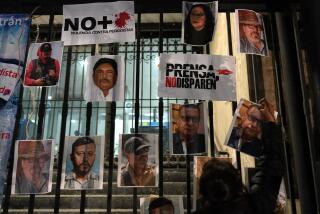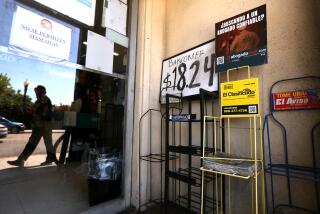Postage stamp to honor Salazar
- Share via
In honor of trailblazing newsman Ruben Salazar’s relentless efforts to chronicle the complexity of race relations in Los Angeles, the U.S. Postal Service in 2008 will issue a commemorative stamp of the former Los Angeles Times reporter and columnist.
“He was a groundbreaker for Latinos in this country, but his work spoke to all Americans,” Postmaster Gen. John E. Potter said Monday. “By giving voice to those who didn’t have one, Ruben Salazar worked to improve life for everybody. His reporting of the Latino experience in this country set a standard that’s rarely met even today.”
It was the way Salazar died that made him a martyr to many in the Mexican American community. His head was shattered by a heavy, torpedo-shaped tear gas projectile fired by a sheriff’s deputy during a riot Salazar was covering in East Los Angeles on Aug. 29, 1970.
Salazar was 42.
“Ruben Salazar put an indelible stamp on the profession of journalism in Los Angeles,” said Los Angeles Mayor Antonio Villaraigosa. “From the battlefields of Vietnam to the streets of East L.A., he reported the news with a rare combination of toughness and humanity. It’s great to finally see his legacy honored on a national level with the issuance of this postage stamp.”
Tens of millions of the first-class 41-cent stamps will be issued some time next year, Postal Service officials said. It will be among five stamps honoring U.S. journalists to be officially unveiled in Washington on Oct. 5.
“Ruben Salazar was a courageous and pioneering journalist, and we were honored to have him as a colleague at The Times,” said Los Angeles Times Publisher David Hiller. “This commemorative stamp is a fine tribute to his legacy that lives on in the communities he served so resolutely.”
Parks, schools, libraries and highways have been named after Salazar, and books, murals, plays and films have been inspired by his life.
Media and corporate foundations each year donate millions of dollars to honor Salazar through scholarships and awards.
Some Mexican Americans called him la voz de la Raza, the voice of the people, and his often blunt columns spoke to the desires and frustrations of a community. The year he died, he wrote:
“Chicanos feel cheated. They want to effect change. . . .
“That is why Mexican American activists flaunt the barrio word Chicano -- as an act of defiance and a badge of honor. Mexican Americans, though large in numbers, are so politically impotent that in Los Angeles, where the country’s largest single concentration of Spanish-speaking live, they have no one of their own on the City Council.”
When told that Salazar was to be honored with a stamp, Ray Reyes, principal of Ruben Salazar High School, a continuation campus of 260 students in Pico Rivera, said, “Awesome! I always wear my Ruben Salazar staff shirt on Fridays, and it’s amazing how many people know who he was -- and I’m talking about students who weren’t even born when he was writing his columns.”
Postal Service officials said it was supporters like Olga Briseño, director of the University of Arizona’s Media, Democracy & Policy Initiative, who made the idea of a commemorative stamp a reality.
Over the last two years, Briseño and a small army of Latino studies students, elected officials, organizations and entertainers, including members of the band Los Lobos, collected 10 pounds worth of petitions and resolutions, which were dispatched to the Postal Service.
“We never gave up,” Briseño said. “We anticipated every possible way they could turn us down, then filled in those gaps.”
Salazar was 8 months old when his parents moved from Juarez to El Paso, where he became a naturalized citizen. He attended the University of Texas at El Paso and earned a journalism degree.
He got his start in 1955 at the El Paso Herald-Post. In 1963, four years after he stepped into the Los Angeles Times newsroom, Salazar won awards for a hard-fisted series examining problems and issues that still plague the Latino community today: substandard education, disproportionate high school dropout rates, immigration and the search for identity in U.S. society.
As a Times correspondent in the 1960s, Salazar covered the Dominican Republic, the Vietnam War and Mexico.
In 1969, he returned to Los Angeles to report on the Mexican American community.
In January 1970, he left The Times to become news director for the Spanish-language television station KMEX. He was labeled a left-leaning Latino agitator by police, but that was an unlikely description of the man who had married a white woman, lived in an Orange County home with a swimming pool and called himself “middle-class Establishment.”
On a sweltering, smog-shrouded Saturday afternoon, about 20,000 marchers who had gathered in East Los Angeles to protest the Vietnam War clashed with sheriff’s deputies. When the smoke cleared, millions of dollars worth of property had been damaged, 60 people were injured and three people were dead, including Salazar.
His death jolted those who admired him. Among them was Frank Sotomayor, a reporter with Army Stars and Stripes, who had arranged to meet Salazar for a job interview.
“On the day I was discharged from the Army, I opened the San Francisco Examiner and saw a story on the bottom of the front page saying Salazar had been killed,” recalled Sotomayor, associate director of USC Annenberg’s Institute for Justice and Journalism.
“As Mexican Americans,” Sotomayor said, “we felt he spoke for us -- that he reflected what was in our heads and in our hearts, even if we didn’t necessarily agree with every one of his opinions. I think this stamp will give him the wider recognition he deserves as a pioneer of journalism.”
Inspired by Salazar’s legacy, Sotomayor and the dozen Latino journalists working in Los Angeles at the time formed a professional organization, the California Chicano News Media Assn., to encourage other ethnic minorities to pursue careers in journalism. Over the years, the group, which has since changed it name to CCNMA Latino Journalists of California, has awarded nearly $700,000 in scholarships to 680 students and sponsored 29 journalism opportunity conferences.
Briseño, the Arizona journalism professor, had worked closely on the stamp project with the Salazar family, which gave the Postal Service permission to use Salazar’s image.
In an interview, Lisa Salazar Johnson, 46, one of Salazar’s three children, said, “When the Postal Service sent me a copy of the color image they planned to use, I cried. To see the ’41 cents’ on a real live U.S. stamp with Dad’s picture on it made me utterly proud of his accomplishments.
“However, I think he would have laughed at this honor as ridiculous,” she said. “Then he would have been deeply humbled by it.”
--
More to Read
Sign up for Essential California
The most important California stories and recommendations in your inbox every morning.
You may occasionally receive promotional content from the Los Angeles Times.











